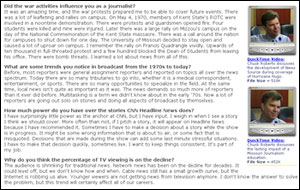MU Researcher Finds More Effective Ways to Converge Media
New Study Will Help Online Reporters Optimize Results
By Nathan Hurst
MU News Bureau
Columbia, Mo. (March 4, 2010) — The Internet has created many new opportunities in the past two decades. For news organizations, it has given an outlet for a virtually unlimited amount of space to post content. The Internet now allows news organizations the opportunity to converge all types of different media for a single story without worrying about size and time constraints.

While news outlets worldwide are taking advantage of the opportunities in media convergence online, the most effective combinations of media for relaying information are still unknown. Kevin Wise, assistant professor of strategic communication at the Missouri School of Journalism, is studying the way viewers process various media when they are combined. Wise believes his research can help online reporters and producers make the most out of whatever content they post.
“If the goal is to maximize what people take away from a story by combining different media, it would be a good idea to think about how different combinations of text and video affect what viewers take away,” Wise said.
In his recent study, Wise looked at the two primary newswriting styles, the inverted pyramid and the narrative, to discover how each style would affect the way viewers mentally process a related video that accompanied the text. Inverted pyramid style involves placing the most important fact of the story at the top and continuing on with each fact in order of importance. Narrative style is a more chronological and focuses more on story-telling rather than fact listing.

During the study, test subjects were shown four different stories, two written in inverted pyramid style, and two in narrative style. Each story would have a related video paired with the text in a manner similar to what a viewer can find on many news Web sites. After reading each text-based story, the subjects then watched the video. After viewing the video, a test was given to determine how well the subject remembered the information shown in the video. Wise found that subjects scored much higher on video accompanying the story written in the narrative style than the video that followed the inverted pyramid-style story.
“What we found is that a narrative-based story seems to be a little bit easier for the mind to deal with,” Wise said. “It’s more vivid and puts things in a sequential order that makes the transition to video easier on the reader, cognitively speaking.”
Wise believes that if narrative-based stories are easy for the brain to process, more mental resources remain for the brain to use on processing additional information.
“We are operating with a limited cognitive capacity,” Wise said. “We all have a bank account of resources that we can use to deal with what is going on in the environment. If more resources are spent on the text before the video, there will be fewer resources left to deal with the video. This will cause memory and attention to suffer.”
While Wise believes further study is necessary, he says this is a key component to understanding how media consumers mentally process news.
This study was published in the Journal of Broadcasting and Electronic Media.
Updated: May 7, 2020